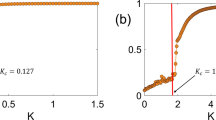Abstract
A distributed variant of the Higgins glycolytic model with the diffusion is considered. A parametric description of the zone with Turing instability is found. By computer simulations, a process of the spatial pattern formation is studied. The multistability of the distributed Higgins model was discovered and the variety of patterns and their amplitude characteristics were described. In the quantitative analysis of the transient processes with varying spatial modality, the method of harmonic coefficients is used. For the stochastic variant of this model with multiplicative random disturbances, noise-induced transitions between coexisting patterns and the phenomenon of “stochastic preference” are discussed.
Graphical abstract

Similar content being viewed by others
References
A.M. Turing. Philos. Trans. R. Soc. London Ser. B, Biol. Sci. 237, 37 (1952)
G. Nicolis, I. Prigogine,Self-Organization in Nonequilibrium Systems (Wiley, New York, 1977)
R. Hoyle,Pattern Formation: An Introduction to Methods (Cambridge University Press, Cambridge, 2006)
M. Cross, H. Greenside,Pattern Formation and Dynamics in Nonequilibrium Systems (Cambridge University Press, Cambridge, 2009)
Y. Kuramoto,Chemical Oscillations, Waves, and Turbulence, (Springer, Science & Business Media, Berlin, 2012)
T. Kohsokabe, K. Kaneko, Europhys. Lett. 116, 48005 (2016)
M. Meixner, A. De Wit, S. Bose, E. Scholl, Phys. Rev. E 55, 6690 (1997)
I. Prigogine, R. Lefever, J. Chem. Phys. 48, 1695 (1968)
R. Peng, M. Wang, J. Math. Anal. Appl. 309, 151 (1964)
G. Gambino, M.C. Lombardo, M. Sammartino, V. Sciacca, Phys. Rev. E 88, 042925 (2013)
E. Ekaterinchuk, L. Ryashko, AIP Conf. Proc. 1773, 060005 (2016)
M. Baurmann, T. Gross, U. Feudel, J. Theor. Biol. 245, 220 (2007)
J. Smith-Roberge, D. Iron, T. Kolokolnikov, Euro. J. Appl. Math. 30, 196 (2019)
S. van der Stelt, A. Doelman, G. Hek, J.D.M. Rademacher, J. Nonlinear Sci. 23, 39 (2013)
W. Horsthemke, R. Lefever,Noise-Induced Transitions: Theory and Applications in Physics, Chemistry, and Biology (Springer, Berlin, 1984)
A.S. Mikhailov, A.Yu. Loskutov,Foundations of Synergetics II: Chaos and Noise, (Springer, Berlin, 1996)
D. Valenti, L. Tranchina, M. Brai, A. Caruso, C. Cosentino, B. Spagnolo, Ecol. Modell. 213, 449 (2008)
O.A. Chichigina, A.A. Dubkov, D. Valenti, B. Spagnolo, Phys. Rev. E 84, 021134 (2011)
I. Bashkirtseva, L. Ryashko, Physica A 491, 28 (2018)
A. La Barbera, B. Spagnolo, Physica A 314, 120 (2002)
A. Fiasconaro, D. Valenti, B. Spagnolo, Acta Phys. Pol. B 35, 1491 (2004)
D. Valenti, A. Fiasconaro, B. Spagnolo, Acta Phys. Pol. B 35, 1481 (2004)
P. D’Odorico, F. Laio, L. Ridolfi, Geophys. Res. Lett. 33, L19404 (2006)
V.O. Kharchenko, D.O. Kharchenko, Eur. Phys. J. B 85, 383 (2012)
M.A. Morales, I. Fernandez-Cervantes, R. Agustin-Serrano, A. Anzo, M.P. Sampedro, Eur. Phys. J. B 89, 182 (2016)
A.I. Lavrova, S. Bagyan, T. Mair, M.J.B. Hauser, L. Schimansky-Geier, BioSystems 97, 127 (2009)
J. Zhou, J. Shi, IMA J. Appl. Math. 80, 1703 (2015)
A. Atabaigi, A. Barati, H. Norouzi, Comput. Math. Appl. 75, 4361 (2018)
J. Higgins, Proc. Natl. Acad. Sci. U.S.A. 51, 989 (1964)
K.W. Morton,Numerical Solution of Partial Differential Equations: An Introduction (Cambridge University Press, Cambridge, 2005)
W.E. Schiesse,The Numerical Method of Lines (Academic Press, Cambridge, 1991)
A.N. Pisarchik, U. Feudel, Phys. Rep. 540, 167 (2014)
L. Ryashko, Chaos 28, 033602 (2018)
Author information
Authors and Affiliations
Corresponding author
Rights and permissions
About this article
Cite this article
Bashkirtseva, I., Pankratov, A. Stochastic Higgins model with diffusion: pattern formation, multistability and noise-induced preference. Eur. Phys. J. B 92, 238 (2019). https://doi.org/10.1140/epjb/e2019-100291-4
Received:
Revised:
Published:
DOI: https://doi.org/10.1140/epjb/e2019-100291-4




